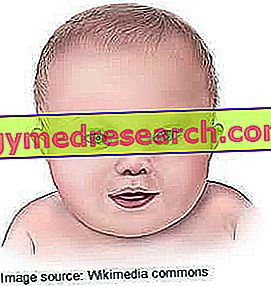What is Down syndrome
In every cell of the human body there is a nucleus in which the genetic makeup is stored. Genes are responsible for all our hereditary traits and are grouped in chromosomes. Normally the nucleus of each cell contains 23 pairs of chromosomes, half of which are inherited from each parent.

When it was discovered
For centuries, people with Down syndrome have been mentioned in art, literature and science treaties. At the end of the nineteenth century John Langdon Down, an English doctor, published an accurate description of a person with Down syndrome. It was with this scientific work, published in 1866, that the doctor gained recognition as "father" of the syndrome. Although other people had previously recognized the characteristics of the syndrome, Down was the first to describe the condition as a distinct and separate entity.
Recently, considerable progress has been made in medicine and science in an attempt to provide as much knowledge as possible about the disease. In 1959 the French physician Jerome Lejeune identified Down syndrome as a chromosomal condition. In place of the common 46 chromosomes in each cell, Lejeune observed that individuals with Down syndrome had 47 chromosomes in the cells. Later it was determined that the characteristics associated with Down syndrome included a full or partial copy of chromosome 21. In 2000, a team of international experts identified and cataloged each of the approximately 329 genes on chromosome 21, thus opening the doors to great progress in the field of Down syndrome research.
How many types of Down syndromes exist?
There are three types of Down syndrome: non-disjunction trisomy 21, translocation down syndrome and mosaic mosaic Down syndrome.
- Trisomy 21 from non-disjunction : it is usually caused by an error in cell division, called "non-disjunction". This error involves the origin of an embryo with three copies of chromosome 21 instead of the classic two copies. It happens that before conception or at the moment of conception, a pair of chromosomes 21 in the sperm or egg cannot separate. During embryo development, the extra chromosome is then replicated in every cell of the body. This type of Down syndrome, which makes up about 95% of cases, is called trisomy 21.
- Down syndrome with mosaicism: it occurs when the non-disjunction of chromosome 21 occurs in one, but not all, the initial divisions of the cell after fertilization. When this happens, there is a mixture of two cell types, some containing the normal 46 chromosomes and others containing 47. The cells with 47 chromosomes contain an extra 21 chromosome. Mosaic Down syndrome accounts for about 1% of all cases. Experts have indicated that subjects with mosaicism present few features of Down syndrome compared to other forms of the disease.
- Translocation Down Syndrome: represents about 4% of all Down syndrome cases. In the translocation, part of chromosome 21 breaks down during cell division and attaches to another chromosome, usually chromosome 14. While the total number of chromosomes in the cells remains 46, the presence of an extra part of chromosome 21 causes the characteristics of Down syndrome.
Causes
Regardless of the type of Down syndrome, all individuals affected by the disease have a critical and extra portion of chromosome 21, which as we have seen may be present in all or only some of the body cells depending on the type. This additional genetic material alters the course of development and causes the characteristics associated with Down syndrome.
The causes that lead to non-disjunction still remain unknown, but research has shown that this chromosymal anomaly increases with the age of the woman. However, due to higher birth rates in younger women, 80% of children with Down syndrome are born to women under 35 years of age.
There are currently no scientific studies showing that Down syndrome can be caused by particular environmental factors or by parental activity before or during the gestation period.
The partial or total additional copy of chromosome 21 that causes Down syndrome can be derived from both the mother and the father. Approximately, only 5% of cases are due to the father.
Probability of having a child Down
Down syndrome occurs in people of all races and social classes, although older women are more likely to give birth to a child with the disease. A 35-year-old woman, for example, has about one chance in 350 of conceiving a child with Down syndrome, but this risk gradually increases to about 1 in 100 by the age of 40. At the age of 45 the incidence becomes about 1 in 30.
Since many couples postpone the possibility of becoming more mature parents, the risk of conceiving children with Down syndrome increases accordingly. Therefore, genetic counseling for parents is increasingly important. In spite of everything, doctors are not always completely well informed in advising their patients about the incidence of Down syndrome, progress in diagnosis and protocols for the care and treatment of affected children.
Below, we report a simple calculation form to quantify the theoretical risk of giving birth to a child with Down syndrome, in relation to maternal age.
All three types of Down syndrome are genetic conditions (related to genes), but only 1% of all cases of the disease have a hereditary component. In particular, we have seen that inheritance is not a causal factor in trisomy 21 from non-disjunction and in mosaicism. In contrast, one third of the cases of translocation Down syndrome show a hereditary component. In this sense, the mother's age seems to be unrelated to the risk of translocation.
Diagnosis
Prenatal diagnosis
There are two types of tests that can be performed before the baby is born: screening tests and diagnostic tests for Down syndrome. Prenatal screening makes the couple aware of the likelihood that the fetus is suffering from Down syndrome. It should be noted that most of these tests provide only a probability. Diagnostic tests, on the other hand, can provide a definitive diagnosis with almost 100% accuracy.
Most screening tests include a blood test accompanied by an ultrasound. The blood test, along with the mother's age, is used to estimate the likelihood of having a child with Down syndrome. Usually it is followed by a detailed ultrasound to check the "markers" (morphological characteristics that according to some researchers would have a significant association with Down syndrome). Current technologies allow a prenatal screening able to highlight the chromosomal material of the fetus that circulates in the maternal blood. These tests are not invasive, but provide high accuracy, even if they are not always able to diagnose the disease.
The procedures available for prenatal diagnosis of Down syndrome are chorionic villus sampling and amniocentesis. These procedures, which are invasive, can cause an abortion (it happens in about 1% of cases or less depending on the skill of the operator), but they are 100% accurate in the diagnosis of Down syndrome. Amniocentesis is usually performed in the second trimester of pregnancy after 15 weeks of gestation, while the chorionic villus examination can be performed already in the first trimester between 9 and 11 weeks.
Down syndrome is generally identified at birth by the presence of some physical traits such as: low muscle tone, a single deep furrow running through the palm of the hand and an inclination towards the other of the eyes. Since these characteristics may also be present in children without Down syndrome, a chromosomal analysis called karyotype is performed to confirm or deny the diagnosis. To obtain the karyotype, a blood sample must be extracted from which the child's cells will be examined. Special tools are used to photograph chromosomes and group them by size, number and shape. Once the karyotype is obtained, the doctors are able to diagnose Down syndrome.
Impact on society
Individuals affected by Down syndrome are increasingly integrated into organized society and communities, such as school, health care, work and social and recreational activities.
Down syndrome is characterized by cognitive delays that can be mild to severe, although most people have mild or moderate cognitive delays. Thanks to advances in medical technology, today the average life span of individuals with Down syndrome has become longer than in the past, in fact 80% of individuals affected by the disease can live up to the age of 60 and many live longer.



